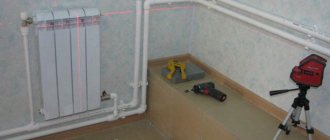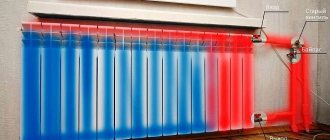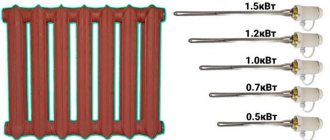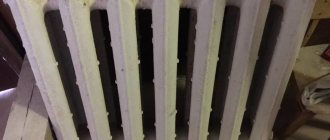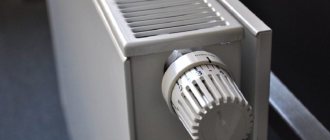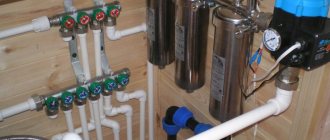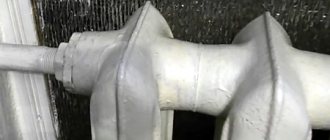How to properly shut off a battery?
The answer to the question of how to turn off the heating battery is extremely simple - just close one tap, leaving the second open. But which tap should you turn off?
As we understand, water is supplied to the heating riser from below.
Let's consider the options
:
- The top tap is closed and the bottom tap is open. If repair work is carried out at the neighbors below or in the basement, or on the branch that supplies the house, the coolant will be drained and your radiator will be empty. If it is steel or cast iron, it will cause corrosion.
- The bottom tap is closed and the top tap is open. Regardless of any repairs, the radiator will be full.
So, we have learned how to shut off the battery for the summer season: to do this, close only the lower ball valve.
When cold weather sets in, watch for announcements at the entrance about the beginning of the heating season. Then close both ball valves so that no debris gets into the radiator - let it all pass through the bypass. In this case, there is no risk of battery rupture with the taps closed - in one or two days, sufficient pressure will not be able to form inside the radiator. During this time, the apartment will also not have time to freeze, especially since the room will be slightly heated from the riser.
How to turn on the radiator? There is nothing complicated about this - just open both ball valves and the coolant will begin to circulate normally through the switched on radiator.
On the first day of turning on the heating, when you hear the murmur of water in the system, do not rush to open the ball valves. The next day you can open them using the Mayevsky valve to release air.
Conclusion
This will require
:
- Ball Valves;
- bypass;
- air vent.
The work of installing bypass and ball valves must be done by professionals with the assistance of a plumber who will shut off the water in the riser. Please note that welding and related equipment will be required.
Emergency heating battery replacement
Ball valves and bypass are an option
:
- ensure the safety of your batteries from corrosion and contamination;
- do not suffer from the heat during sudden warming during the heating season;
- ensure safety in the event of an emergency - if the radiator fails, it can be disconnected from the system, while the neighbors will not suffer from a flood or lack of heat;
- at any convenient time, replace the old radiator with a new one;
- Remove batteries for washing or painting.
- successfully use modern radiators with a thermostat without disturbing your neighbors.
A competent approach to organizing apartment heating is a concern for comfort and safety.
Video on the topic:
Crimping
When the heating is turned on (at the beginning of the water supply to the network), the plumber should be near the tap in the basement in order to quickly shut off the water supply in case of an emergency. The procedure for supplying coolant under pressure into the system is called “pressure testing”. At the same time, the integrity of the heating system is checked.
When performing pressure testing, special equipment is used: a pressure gauge and a pump, which creates pressure. If the pressure in the system does not drop when coolant is supplied, then there is no leak in the network. If the pressure drops noticeably over time, it means that the tightness of the system is broken, and it is necessary to find damage to the lines and heating devices.
Crimping
Very important information
Below we will describe situations when one or another inclusion of the battery may be undesirable, and sometimes unacceptable!
4.1.You cannot use the thermostat without a jumper
In point 2 we talked about the thermostat. However, you need to understand that experiments with a temperature controller are only possible with a jumper! If it is not there, and you reduce the diameter of the flow pipe, then the total flow of hot water through your apartment will decrease. Which of course is unacceptable, otherwise your neighbors will come to you!
4.2. The thermostat may become clogged
If you are using a jumper, but for some reason it was turned off for a while and the thermostat was set to position 5, i.e. provided a full flow of hot water only through the battery, as shown in the figure:
then everything seems to be fine. However, we must accept reality as it is. Even if we turned on the central heating radiators correctly for the first time, there is no guarantee that, for example, in a month or two a new mud flow will not pass through the pipes. But then, if the jumper is turned off, then the splash of dirt will go straight to your thermostat, which, in fact, is very sensitive to it. As a result, a blockage forms in the thermostat, and water will not flow into the battery at all. It won’t go into the jumper either, because you closed it. Therefore, in this situation, water will stop flowing through your apartment; in the house, through your heating riser, the water will also stop and begin to cool in the cold. As a result, a squad of evil neighbors, together with the chairman of the HOA or housing cooperative, is guaranteed to enter your apartment.
It is clear that switching on according to the above figure is similarly not acceptable for the regulator positions 4,3,2,1,*
4.3. The jumper must always be on
Make it a rule that it doesn’t matter whether you use a temperature controller or not, but the jumper should always be on. Thus, you will always ensure the flow of hot water through your apartment
When does it make sense to turn off the jumper? For example, when you feel that the battery is clogged. Then you let all the water flow through the battery by disconnecting the jumper. Perhaps a more powerful stream of hot water will be able to push through the stuck dirt. But this needs to be done for a short time and only under your control - you cannot leave the situation like this and go to sleep. The fact is that if the dirt cannot be pushed through, then a congestion will form again: water will not be able to pass through either the battery or the jumper.
This is mega important, because if it is installed before the jumper, then when you first turn it on, dirt will definitely clog your thermostat, and you will start the heating season with a complete rewiring of the battery:
conclusions
Services for disconnecting water supply risers for the purpose of carrying out any work on the individual property of the owner of the premises are performed by the management company/homeowners association outside the scope of services and work on the maintenance of residential premises and are subject to separate payment by the owner, on the initiative and for whose purposes such services are provided.
The position presented in this article is confirmed by a number of judicial acts, including: 1. Appeal ruling of the Moscow City Court dated June 24, 2013 in case No. 11-1916013;2. Decision of the Sovetsky District Court of Krasnoyarsk dated July 12, 2011 in a civil case at the claim of the prosecutor of the Sovetsky District of the city.
Krasnoyarsk, in the interests of an indefinite number of persons, to LLC "Enterprise Zhilremservis" to recognize as illegal the actions of collecting fees from citizens for performing work to disconnect hot and cold water supply risers;3. Resolution of the Sixth Arbitration Court of Appeal dated September 13, 2013 No. 06AP-3487/2013 in case No. A73-4100/2013.
Installation and connection
After studying the design and purpose of the bypass, it is necessary to find out the features of its installation. When installing a device in a system, certain factors are taken into account, among which the most important are the following:
- the bypass diameter is smaller than the diameter of the supply and return pipes (if the liner has a diameter of 3/4″, then the bypass is 1/2″);
- the temperature at the bypass installation location is the lowest;
- maximum proximity to the radiator and distance from the riser;
- installation in a horizontal position, which avoids airing;
- the ability to quickly dismantle the radiator requires the installation of shut-off elements, for which ball valves are used.
Connected drain pipe.
Installing a bypass channel for the radiator
When connecting new radiators to an old one-pipe system, it is first necessary to ensure that the coolant is drained. Next, the radiator body kit is assembled. Old cast iron batteries are cut off with a grinder, and unnecessary parts of a pipe with a non-working tap are unscrewed using pipe wrenches. Then the thread is cut and the structure is assembled, the elements of which are a tee, an extension and ball valves with an American connection.
The radiator screens are attached before installing it on the wall. When assembling a heating system with a bypass, you must remember to maintain the required radiator center distance. At the last stage, the pipes are cleaned and painted.
Installation with circulation pump
If it is necessary to install a circulation pump, a cleaning filter is used in the system to protect the expensive blower mechanism from impurities in the coolant. The protective properties of the filter are ensured by a metal mesh that traps large particles of contaminants. The filter has a special container for collecting contaminants, equipped with a hole for cleaning. When installing, it is recommended to place the filter with the drain hole facing down. A cleaning filter is installed directly in front of the pump inlet.
https://youtube.com/watch?v=22c2iR87zxw
When using a circulation pump, a check valve is used as a shut-off element, without which the coolant will only flow in a small circle. However, a ball valve is more reliable than a valve, ensuring automatic operation of the system. In old single-pipe circuits, the second option is applicable.
In the first case, the bypass in the heating system is installed on both the return and supply pipelines, and in the second - only on the return pipe.
Possible reasons and procedure for replacing the bypass section
During operation of the heating system, it may be necessary to replace the bypass channel. The need to carry out this operation is due to the failure of the device or the need to install additional components within it. When using modern polypropylene pipelines, the first option is unlikely, so replacement in most cases is carried out to install a check valve or ball valve.
The order of the operation depends on how the bypass section is connected to the circulation pipeline. With a detachable threaded connection, the bypass section is connected to the inlet and outlet pipes through tees. When dismantling, it is necessary to unscrew the nut with a clamp or an American one. If it is planned to replenish the bypass, the length of its pipe must be reduced by the appropriate amount.
Disabling radiators without fittings
It is no secret that in most apartments to this day there are old cast iron radiators or steel convectors without any shut-off fittings, which makes it impossible to shut them off during the heating season. Moreover, according to the old heating scheme, convectors in high-rise buildings are connected to risers without straight sections - bypasses. Therefore, if an accident occurs with a coolant leak, you must act as follows:
- Try to provide some kind of container to collect hot water. If the stream flows to the side, wrap a thick cloth over the break site so that the water flows along it into a bucket.
- Call the dispatch service of your heating energy supply company and report the accident.
- While the service personnel are getting there, provide them with access to the basement, find the keys, open the door, and so on.
- Try to block the riser yourself.
While your water is flowing onto the floor, your neighbors’ suspended ceiling turns into a bubble
A few words about how to properly turn off the heating riser. Find in the basement the heating point of your entrance and vertical pipes embedded in a large-diameter main or into a common collector. Follow where they go to determine the emergency riser, and turn it off with a tap. Contact by cell phone someone in the household who can confirm that the geyser eruption in the apartment has stopped. If you couldn’t find your pipe, close all the valves one by one until you find the one you need.
Attention! Don't try to force yourself on basement valves that are stuck due to rust. When they cannot be closed manually, it is better to wait for a team of plumbers; they will find a way to stop the flow of coolant. Otherwise, a very awkward situation will arise when you also break the main fittings, leaving the apartment building without heat during repairs
Otherwise, a very awkward situation will arise when you also break the main fittings, leaving the apartment building without heat during repairs.
Example of an access heating point and riser connection
It is also worth considering the question of how to shut off the battery if it is hot in the apartment due to the service provider’s failure to comply with the temperature schedule of the boiler room. It would seem that if there are shut-off valves, the problem is solved by manually closing the taps. But after the temperature in the rooms drops, the valves will have to be opened again. This way you will get tired of turning the taps long before the end of the heating season, so you need to think about how you can adjust the heat output of the radiators. The options are:
- if possible, install a thermostatic valve on each radiator, limiting the flow of coolant and automatically maintaining the set temperature in the room;
- It is nice to cover the heating device with a blank screen with small holes if there are no shut-off valves on the connections.
Important. The ball valve is not a means of adjustment; it is intended only to completely cut off or open the passage of the coolant. In the “half closed” mode it will not give the desired effect and will fail much earlier
In the “half closed” mode it will not give the desired effect and will fail much earlier.
Thanks to worn-out pipelines, district heating systems are notorious for dirty water that quickly clogs small passages. Therefore, ordinary valves with thermal heads will not last long here; you need to buy special valves with increased capacity, which are produced by the well-known brands Danfoss and Herz. How to install them on the connection to the radiator is shown below in the diagram and described in this material.
Radiator thermostat installation diagram
When it’s hot in an apartment in the middle of winter and there are no control valves, residents have no choice but to cover the radiator in the room with a decorative screen. The principle is simple: the radiator will heat the air inside the box, after which the intensity of heat transfer will sharply decrease due to the small difference in the temperatures of the air and the surface. That is, the coolant will give off less energy, and the amount of hot air coming out from under the screen will be limited by the size of the decorative openings. How to assemble and install a nice MDF box on a heating device is shown in the video:
Correct thread installation
Threading pipes may seem like a simple task to an experienced professional, but the process may be unfamiliar to a novice pipe fitter.
- Using a file or turbine, it is necessary to remove the chamfer, after which an entry for the die will be made.
- The die with the holder on the long side is placed on the tube. This operation is necessary for a perpendicular entry of the die onto the pipe.
- Short threads are applied to the riser, not exceeding five threads. The thread is applied strictly clockwise.
- When the die approaches the edge of the tube, it is worth pressing the holder as powerfully as possible with all your might.
- After cutting the first thread, you need to hold the riser with a gas wrench. The maximum force is applied so that the rotational moment of the die can be compensated, since otherwise it will be possible to break the thread of the riser on the floor above or below.
- If a convector is mounted for welding, then there is no need to hold the structure, since it is impossible to tear out such a riser.
- It is necessary to cut a long thread on the connection to the radiator and on the outlet in the jumper.
- During the cutting process, a piece of tube must be fixed with a vice in order not to destroy the structure of the already cut thread.
What is required to shut off heating devices?
If it’s hot in the apartment or you need to disconnect the radiator without calling a plumber to shut off the entire heating riser in the entrance, it is important that:
- Between the supply pipe and the return pipe there was a vertical jumper - a bypass; it is through it that the coolant flow will pass without entering the installed battery after you turn it off. The absence of a bypass automatically means that you are cutting off the flow to the entire riser.
- American ball valves must be installed on the supply and return pipes between the bypass and the heating radiator. They are the ones who make it possible to disconnect.
- Ideally, an air valve is installed at the radiator inlet.
Based on the above, if there is no bypass, but ball valves are installed, the battery can be dismantled independently for repair or replacement, but not during the heating season.
The bypass (jumper) is mounted parallel to the radiator and is usually a pipe whose diameter is equal to the diameter of the supply pipes or one step smaller. If you plan to shut off the radiators after the heating season or install a radiator with a thermostat, be sure to take care of installing a bypass. Otherwise, your actions will lower the temperature of the coolant and your neighbors.
Is it possible to shut off by closing both taps?
Let's imagine that you closed both taps while the coolant in the system is still hot.
Knowing the elementary laws of physics, you can easily understand that
- As the water in the battery cools, its volume will decrease;
- This will lead to the formation of a vacuum in the enclosed space of the radiator;
- As a result of the resulting pressure, the battery will become deformed or lose its seal and will need to be replaced.
So, in search of an answer to the question of how to turn off the battery if it gets hot in the apartment, you already know that this should under no circumstances be done by closing both taps! Now it remains to figure out whether it is worth using both taps after the heating season, when the coolant has already cooled down.
As we already know, the central heating system stays full all year round. In some areas, the coolant is drained if repair work is required, and then refilled. So there is liquid inside your radiator.
If you turn off both the upper and lower valves, the following happens:
- Various chemical processes take place in the liquid inside the battery, since the coolant cannot be chemically pure;
- As a result of these processes, gas formation occurs;
- Since the gases have no way to escape, the increased pressure may cause the radiator to depressurize.
Thus, if an air vent (Mayevsky tap) is not installed on the battery, it is strictly not recommended to close both shut-off valves, even if the coolant temperature is room temperature.
Correct procedure
A bypass is a small branch from the common riser in the form of a connecting jumper between pipes. The presence of a bypass will ensure that you are cutting off the battery only in your apartment, and not in the entire house. If your heating system is connected exactly as in the figures above, then in order to shut off the battery you need to use taps. The question arises: should you use the top or bottom tap?
You need to know right away that you don’t need to close two taps! As we already know, hot water flows through the pipes in winter, heating the heater. If you turn off both taps, the temperature of the water inside will drop sharply. It would seem that this is what we need! But at the same time, the volume of water filling the radiator will decrease. And the empty space will be filled by a vacuum, which creates pressure inside.
As a result of excess pressure, the battery may crack or even burst! To painlessly turn off the heating if you are hot, you just need to close the bottom tap. The top one remains open so that the heater is full and does not create a vacuum or air pockets.
That is, your procedure consists of 3 points:
- Feel that you are hot.
- Make sure your system is equipped with valves and a bypass.
- Close the bottom tap, but do not touch the top one.
How to shut off a battery without a valve
Let's say that your apartment is heated by a two-pipe heating system; it is not equipped with a shut-off jumper and taps. As a rule, these are outdated cast iron monsters that are still found in homes. Is it possible to block it?
Figure 4 – Battery connected without a jumper in a two-pipe circuit
Unfortunately, it is impossible to turn off such a system during the heating season. By shutting off this battery, you will block the riser and the whole house will freeze. You can turn off the two-pipe circuit yourself only if a pipe in your apartment breaks, or if the battery leaks.
This is done as follows:
- Go to the entrance heating point.
- You are looking for 2 vertical pipes that go up to your apartment.
- Turn the taps on them, i.e. turn off the heating throughout the house.
- Explain the situation to your neighbors.
Ways to solve the problem
Obviously, this method of adjusting the air temperature is unlikely to help you. There are several ways to deal with batteries that cannot be plugged.
Screen
They are not cheap, but they have a lot of advantages. This is an aesthetic appearance, protection from children and a reduction in the intensity of heat transfer. The amount of heated air from the battery will be limited by the screen frame and therefore the air temperature will not rise so quickly.
Figure 5 – screen covering a two-pipe circuit
Regulator-thermostat
Such devices are installed on each heater. They are useful because they can change the diameter of the pipe that supplies hot water to the radiator. The problem with this method is that without a cut-off jumper, the flow of hot water will decrease in all apartments. This smoothly brings us to the third solution to the problem.
Battery Replacement
Wait until the end of the heating season, hire a welder and install a bypass, shut-off valves, ball valves and a modern radiator. You will not have such problems in the future. This is the most expensive, but also the surest path. If you quickly install the jumper during the heating season, you can turn off the heating in the apartment and replace the cast-iron battery with a brand new aluminum one.
An optimal microclimate in an apartment is the key to happiness and well-being. After all, as you know: the most important thing is the weather in the house. And this article will help you maintain the desired temperature in your apartment.
Thermal head - EC
Thermal heads for heating radiators.
A device that allows you to regulate the temperature of heating radiators is called a thermal head. This is not the only name for this device; there are also: battery thermostat, thermostatic head, battery temperature controller, radiator thermostat, radiator thermostat and others. Let's talk in more detail about this device.
Various types of thermal heads for heating radiators.
- Operating principle.
- Classification.
- Installation options.
- Settings.
- Conclusion.
The design and principle of operation of a thermal head for a heating radiator.
The thermostatic head can only be used in conjunction with a thermostatic valve. The thermostatic valve refers to shut-off and control valves and, using a thermal head, can regulate or shut off fluid flows in the system.
Construction of a thermostatic heating head and thermostatic valve.
The ambient temperature near the thermal head affects the state of the substance in the bellows. By decreasing or increasing in volume, the substance affects the position of the pressure rod and thereby regulates the volume of coolant entering the radiator. When the air temperature in the room rises, the substance in the bellows begins to expand, squeezing out the rod, which in turn reduces the cross-section of the channel, and the volume of coolant entering the radiator is reduced. When the temperature drops, the opposite process occurs: the substance in the bellows is compressed, due to which the rod rises, increasing the cross-section of the channel, and the volume of incoming coolant increases.
The opening and closing of the stem is facilitated by two stainless steel springs: one returns the stem after closing the valve, the other after opening.
It is IMPORTANT to remember that for the thermal head to function properly, it must be periodically cleaned of dust and dirt. Please remember that cleaning agents and abrasives should not be used for cleaning.
Thermal head and valve in section.
Classification of radiator thermal heads.
All radiator thermal heads can be divided into two types:
mechanical - adjustment is carried out manually;
electronic – the adjustment process occurs automatically.
Mechanical models are a head of various sizes with a rotary handle. The temperature range can be controlled. In various models it starts from +5 °C and reaches +28 °C. The thermostatic head provides several operating modes, dividing the temperature scale. Each division is equivalent to 2-5 °C.
Mechanical thermal head for a heating battery.
Electronic thermal heads for controlling heating radiators are multifunctional thermostats that allow you to reduce heat energy consumption due to the possibility of programming. Let's look at the various functions that electronic battery regulators have.
Possibility of precise temperature adjustment by 0.5 °C;
Possibility of temporary temperature programming;
Instant control of room temperature, providing comfort and saving your money for heating;
Possibility of programming comfort temperature and reduction temperature for each day of the week;
Possibility of additional configuration of various factory modes, as well as individual operating modes of the battery thermostat;
Additional functions: vacation/party, child/external protection;
Large backlit display designed for ease of use;
Types of heating systems and the principle of adjusting radiators
Handle with valve
In order to correctly adjust the temperature of radiators, you need to know the general structure of the heating system and the layout of the coolant pipes.
In the case of individual heating, adjustment is easier when:
- The system is powered by a powerful boiler.
- Each battery is equipped with a three-way valve.
- Forced pumping of coolant has been installed.
At the stage of installation of individual heating, it is necessary to take into account the minimum number of bends in the system. This is necessary in order to reduce heat loss and not reduce the pressure of the coolant supplied to the radiators.
For uniform heating and rational use of heat, a valve is mounted on each battery. With it, you can reduce the water supply or disconnect it from the general heating system in an unused room.
- In the central heating system of multi-storey buildings, equipped with a vertical supply of coolant through a pipeline from top to bottom, it is impossible to adjust the radiators. In this situation, the upper floors open the windows due to the heat, and the rooms on the lower floors are cold, since the radiators there are barely warm.
- A more advanced one-pipe network. Here, the coolant is supplied to each battery and then returned to the central riser. Therefore, there is no noticeable temperature difference in the apartments on the upper and lower floors of these buildings. In this case, the supply pipe of each radiator is equipped with a control valve.
- A two-pipe system, where two risers are mounted, ensures the supply of coolant to the heating radiator and back. To increase or decrease the coolant flow, each battery is equipped with a separate valve with a manual or automatic thermostat.
Energy consumption for a bypass pipe with a thermostat
Installing a thermostat has a beneficial effect on energy costs. Compared with a conventional flow pipe, in a system with a bypass pipe, hot water consumption is reduced by 30-35%, and heat transfer from the radiator is reduced by 10%. This is of no small importance when there is excess heat in the heating system, that is, when the apartment is hot. This indicates the effectiveness of the system using a bypass for creating comfortable conditions in the room, and payments for energy consumption are significantly reduced.
Heating Systems Basics
In general, according to the regulations of utility services, it is prohibited to interfere with the operation of the central systems of the house. In exceptional cases, when the battery is leaking or has ruptured, emergency intervention is permitted. But if the heating system in your home is connected to the central system correctly, then you can try turning off the heating yourself. There is nothing particularly difficult about this.
Correct connection means that the heating is connected to the general system using two ball valves (Figure 1) and a jumper called a bypass (Figure 2). This connection is called one-pipe. (Figure 3)
Figure 1 – Two taps
Figure 2 – Bypass jumper
Figure 3 – One-pipe system with a jumper. It can be covered
How to piping a heating system?
Heating radiators in modern heating systems are connected in the following order:
- A control valve is installed between the coolant supply pipe and the radiator. The control valve is a thermostat with a valve or a manual valve.
- At the outlet of the radiator there is a ball valve.
- A jumper or bypass must be installed in front of the input and output shut-off valves. Using a bypass, the coolant can bypass the battery. The jumper is installed only in case of serial connection of radiators. A ball valve is installed in the center of the jumper.
If you correctly piping the heating system with the installation of all shut-off and control valves, then you will be able to:
- Without stopping the entire heating system, stop the operation of one radiator to perform various types of work on it, for example, repair, replacement, flushing, etc.
- Regulate the volume of coolant passing through the battery, thereby increasing or decreasing the temperature.
- Drain the coolant and bleed air from the system.
- Protect the heating system from shelves due to water hammer.
- Save money by regulating heating intensity.
offers a large selection of shut-off and control valves. Our consultants, focusing on your project, will offer the best solution for piping heating systems. Ball valves of any design and size, thermal heads and thermostats, manual valves, main valves - you will find all this and much more by contacting our company. Placing an order is quite simple: you can come to our office, you can place an order on our website, or just call us. When you order a product, we deliver it from the warehouse to the customer’s site.
Design features
The thermostat device is quite simple and consists of a thermal valve and a control element. Since, depending on the conditions, heating systems are installed with pipes of different diameters, thermostats are also produced for pipes of different diameters. As for the regulating element (thermostatic head), its dimensions are of a standard size, therefore they are suitable for regulators of any model, regardless of the manufacturer.
There are not so few models of valves and regulators, so before installing them, it is better to familiarize yourself with the available models, their design, and the principle of operation.
How to properly turn off the heating radiator in an apartment?
Let's begin to step by step analyze the possibility of shutting off the radiator or radiator, if the temperature in the room needs to be lowered by shutting off the heat supply.
Let's start with age. More precisely, the condition of heating radiators, fittings and thermostatic taps, because their condition directly depends on age
If this is an old apartment with cast iron radiators with multi-layer painting, then any manipulations should be done very carefully. If you have any doubt that more effort and something will break off, you should stop
Remember, heating systems are pressure systems, that is, they are under pressure, and any damage to them can lead to depressurization, and, as a result, burns and catastrophic damage to property from boiling water.
- We check the presence of shut-off valves, needle valves or a thermostat of another type on the radiator. If they are, then it becomes possible to shut off the heating device.
- We determine, if possible, the heating scheme you use.
If you have a one-pipe heating system, in which the batteries are connected in a chain without jumpers between the inlet and outlet of the coolant, then it will not be possible to shut off such batteries.
More precisely, if valves are installed at the inlet and outlet, then closing them will stop the circulation in the ring, and therefore the heating of all neighboring consumers above, below or on the sides.
There is a type of single-pipe heating scheme, the so-called “Leningradka”. It is distinguished by the presence of connecting jumpers between the inlet and outlet pipes of the radiator. If you have one transit riser and a jumper with taps or a thermal head is installed, then you can safely shut them off.
The circulation will continue, the coolant will flow through the jumper. Often, in order to be able to direct the entire flow of coolant to the heating device, a shut-off valve is also installed on the jumper itself. If you reduce or block the flow through the battery, then it itself must be open so that the same does not happen to the entire circuit.
You may have a three-way valve installed where the jumper is connected to the inlet pipe into the radiator. It allows you to redirect the coolant circulation in two directions: through the radiator and through the jumper.
A three-way valve makes it possible to reduce the temperature in the heating device or turn it off altogether.
If you have a two-pipe system and have something to close the radiator, feel free to close it. With a two-pipe scheme, shutting off one radiator will not stop circulation in either the forward or return pipelines. It is also possible to independently regulate the temperature in each radiator.
When a radial or collector heating system is assembled, each radiator can be easily turned off using balancers on the collectors. It is imperative to have a legend or signed balancing valves in order to accurately shut off the required battery.
Expert advice
Experts advise that during the heating season, in order to shut off radiators, it is mandatory to use the following devices:
- ball valves;
- bypass with valve;
- drainer;
- thermostat;
- device for removing excess gas.
To learn how to bleed air from a radiator in a multi-story building, see the video below.
For many people, the heating system is a mystery. After all, it consists of rather complex pipe circuits that are interconnected by batteries in each residential apartment. Therefore, if the pipeline breaks down, everyone living in the house will suffer. That is why every person wants to know how to turn off a heating radiator so that not a single apartment is damaged.
If you need to shut off and remove the radiator
It is best to carry out work related to radiator removal after the end of the heating season. If work needs to be carried out during the heating season, you need to take into account a number of nuances. If you have a single-pipe heating system and vertical wiring, you can remove the battery only if there is a bypass.
Such a system can be identified by pipes, one of which comes from the ceiling and connects to the radiator, and the other comes out of the radiator and disappears into the floor. A bypass is a jumper connecting the incoming and outgoing pipes. This is a pipe of approximately the same or slightly smaller diameter than the main pipes. The principle of the bypass is as follows: if the radiator is turned off, water begins to flow through the riser, passing through the bypass, without passing through the battery. In this case, the riser works, the heating in neighboring apartments does not turn off.
If the system is two-pipe, if there are taps, it is enough to close them, after which you can remove the battery.
Tool preparation
Before replacing, you need to prepare a special tool:
- Adjustable wrench,
adjustable wrench
- "Bamka" key
"Bamka"
- Electric drill,
- Drill for working on concrete of the appropriate diameter,
- Angle grinder (“grinder”) with a diamond disc for processing metal surfaces,
Bulgarian
- Tape measure and folding meter,
- Construction pencil, which will be used for marking,
- Water level (“spirit level”).
Level
Important! If you are unable to reach an agreement with your neighbors above or below, you will need a tool, which is necessary for cutting threads. The external thread is cut on the pipe near the floor and under the ceiling.
Three types of bypasses
There are three types of bypasses:
- Unregulated - simple pipe;
- With manual control – valve with divisions;
- Automatic – with sensors;
The latter option is installed in a harness with a pump. Typically, automation is used when circulating a coolant along a circuit. An electrically powered pump allows you to increase the flow rate, which helps reduce heat loss. Most often, such a system is used in private homes or when connecting heated floors to the heating system in apartment buildings. In the event of a power outage, the coolant flow passes through the bypass. The impeller restricts the flow of water. It is supplied to the market in two variations: injection and valve. The biggest disadvantage of an automatic bypass: if the water contains scale, scale, rust and other contaminants, it quickly fails. The bypass must be installed in a single-pipe system; if it is necessary to make a collector wiring, the jumper allows you to divide the flows into two parts, providing both radiators with coolant in equal proportions. With horizontal wiring, the bypass is installed parallel to the main line below the normal wiring. When installing standard three-quarter inch pipes, it is recommended to install a bypass at one-half inch. In this case, the pipes of the incoming and outgoing coolant flow should have a diameter of 1 inch.
Examples of using bypass
Example #1 - adjusting the coolant
The functional purpose of the bypass is to return excess coolant from the heating battery to the riser when its quantity changes using a manual or automatic thermostat. In other words, the coolant is transported through the bypass parallel to the shut-off and control valves. Without this element, it is impossible to repair the battery when the heating system is in working order. The bypass also speeds up the process of filling or emptying the system.
This is how a bypass can be introduced into a heating system
Example #2 - system operation without electricity
Installing a bypass in a heating system is especially important when installing modern heating systems that involve the use of circulation pumps. People who are faced with heating installation for the first time often ask the craftsmen or consultants in stores: “How will the system work if the electricity goes out?” After all, everyone is accustomed to the fact that the standard floor-standing boiler used in the past was not connected to electricity. And equipping the heating system with a circulation pump makes it energy-dependent.
That's exactly where the bypass comes to the rescue in such situations. Its role in this case is very simple - at the moment of a power outage in the network, the consumer must turn off the coolant supply taps to the pump and open the tap on the central pipe. By the way, this can happen automatically if a bypass with a valve is used. These simple manipulations switch the heating system to natural circulation mode.
Installation of devices on the bypass should be carried out towards the coolant in the following sequence:
- filter;
- check valve;
- circulation pump.
It is important to note that the introduction of a bypass into the riser near the circulation pump must be carried out using shut-off valves. It is better to install the element itself horizontally. In this case, the system will be protected from air accumulation
In this case, the system will be protected from air accumulation.
Schematic representation of a bypass pipe built into the heating system
Example #3 - resuscitation of single-pipe heating
Yes, the single-pipe heating system is obsolete today, but it can still be found quite often in Soviet-built buildings. Moreover, there are such miracles when such heating functions very efficiently even in apartments in winter, it’s simply hot. Installing a bypass will also help correct the situation. In principle, there is nothing complicated in this work, but it is still worth meeting some conditions:
- The bypass should be located at the maximum distance from the vertical section of the pipe, that is, as close to the battery as possible.
- The bypass pipe can be made directly at the installation site - a pipe, a tee and welding work will be required. Or you can purchase such an element ready-made and install it on threaded connections.
- The radiator inlet and bypass must be separated by a control valve or radiator thermostat.
By installing such a device, you will get a banal “temperature regulator in the house.”
What to do if the air cannot be displaced?
Unfortunately, an unusual situation may occur and usually working methods will be powerless. This may be due to the absence of neighbors above or the unusual design of the house, but you should always be prepared for the fact that it is not always possible to restore the heat supply to the apartment immediately.
Experienced craftsmen use moving the riser to discharge, as in most cases this allows circulation to be restored. Manipulations are carried out either over plugs or over valves.
To do this, you need to open the valve on one riser, and the vent on the second riser. In this case, the air will leave the battery along with the water. If there is no result, you should perform the same steps, but in the opposite direction.
Results
To fully monitor heating radiators, the following devices are required:
- Ball Valves;
- Bypass with tap;
- Drain tap or hole;
- Thermostat;
- Device for removing gases.
https://www.youtube.com/embed
It is quite easy for the owner of a private house to adjust or repair heating radiators, because he has an individual system. It is more difficult for owners of apartments where vertical single-pipe systems are installed and any manipulations with heating devices in winter can affect their neighbors. The purpose of this article is to explain how to properly shut off the battery in an apartment without causing harm to others.
DESIGN PLACE FOR PLAY
Create a separate space in the room where the baby will be awake. Let the toys lie there, a place will be “cleared” for rolling cars or building pyramids, and don’t let chairs, a table, or a closet get in the way. The child should play with pleasure, he needs a certain place for this. And at the same time, you should not worry that, having played too much, he will crawl in the wrong direction and hurt himself on the table leg, or turn the chair over on himself.

